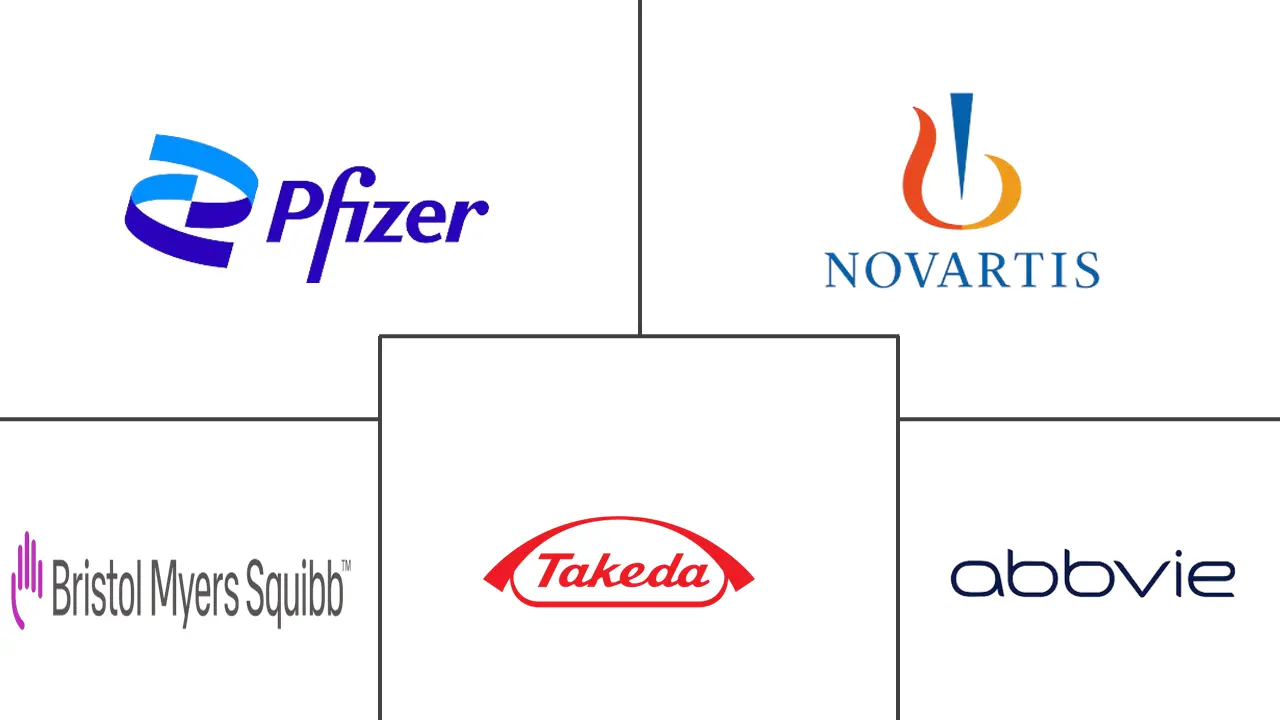Complex Injectables Market Size and Share
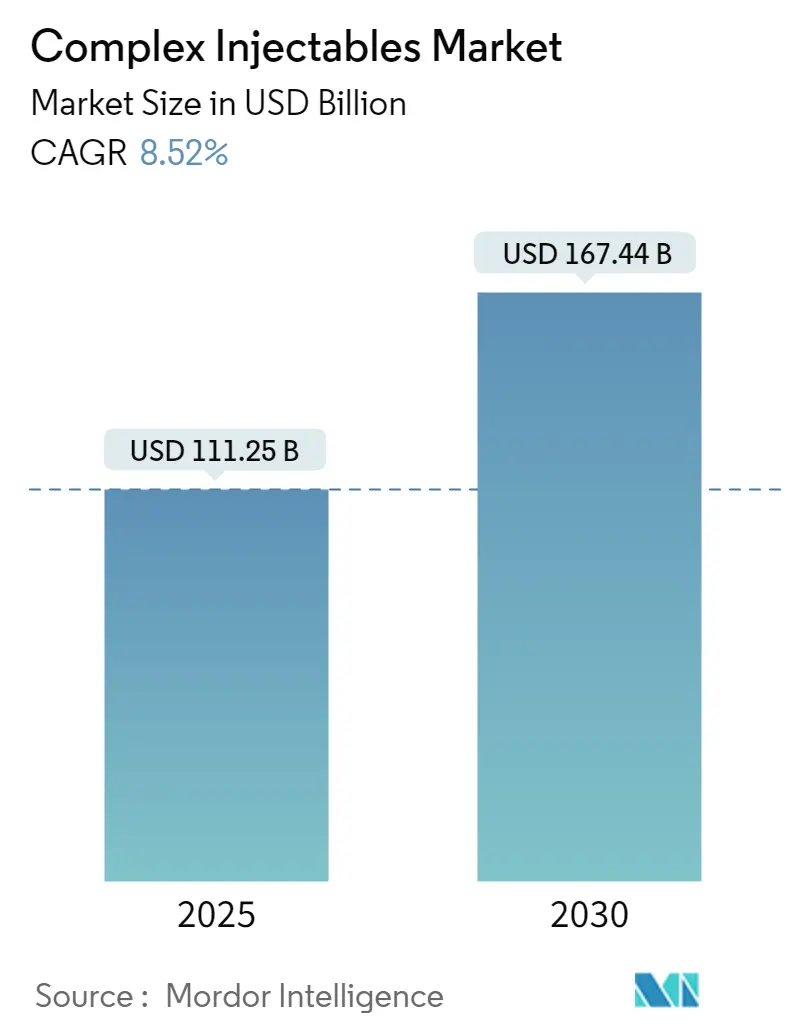
Complex Injectables Market Analysis by Mordor Intelligence
The Complex Injectables Market size is estimated at USD 111.25 billion in 2025, and is expected to reach USD 167.44 billion by 2030, at a CAGR of 8.52% during the forecast period (2025-2030).
The complex injectables market is projected to be driven by factors such as a surge in chronic diseases such as cancer and cardiovascular diseases coupled with technological advancements in drug delivery systems. Moreover, the growing demand for biologics and supportive regulatory frameworks with increasing regulatory approvals are further projected to drive market growth over the coming years.
The rising prevalence of chronic diseases significantly drives the demand for complex injectable products. For example, the American Cancer Society reported a surge in estimated new cancer cases, climbing from 1.9 million in 2023 to 2.0 million in 2024. In 2023, the predominant cancers diagnosed included breast, lung, and hematological malignancies.
Similarly, according to the estimates from the National Cancer Institute of Brazil, around 704 thousand new cancer cases are expected to be diagnosed between 2023 and 2025, except non-melanoma skin cancer. Thus, such an alarming burden of cancer is projected to accelerate the development of advanced drug delivery solutions, thereby fueling the demand for complex injectables market.
The increased demand for complex injectables in managing different chronic conditions and the higher safety associated with their usage is expected to uphold their demand over the study period, thereby supporting the market growth. For instance, according to an article published in Drug Delivery and Translational Research in August 2023, the demand for complex injectable products has increased owing to their effectiveness in managing unmet needs in advanced stages of chronic diseases.
In addition, the above article also highlighted that novel parenteral products, including microspheres, nanoparticles, suspensions, and liposomes, improved the safety and delivery of complex injectable products. Therefore, such benefits associated with complex injectables and their roles in drug delivery are expected to propel their acceptance, supporting market expansion.
Additionally, the significant roles of complex injectables in improving therapeutic concentrations of drug products are expected to offer growth momentum for complex injectable formulations, including liposomes and microparticles, thereby augmenting industry uptake. For instance, according to an article published by Cancer Nanotechnology in May 2024, liposome-based drug delivery showed improved tumor-targeting ability of anticancer drugs and increased accumulation of drugs at the tumor site. Therefore, such an efficient site-targeting capability of complex injectables is projected to accelerate development activities, thereby boosting market growth.
Furthermore, the increased efforts from market players to develop advanced complex injectable offerings are further likely to augment the industry growth. For instance, in December 2023, Zydus Worldwide DMCC entered into a licensing agreement with Daewoong Pharmaceutical Co Ltd to co-develop and commercialize Leuprolide Acetate for Depot Suspension in six dosage strengths for the U.S. market. Hence, such efforts undertaken by key market players to expand the availability of complex injectables are likely to support industry expansion over the coming years.
Therefore, the factors mentioned above are expected to boost market growth. In contrast, the complicated manufacturing process of complex injectables and the high cost of products are expected to impede market growth over the coming years.
Global Complex Injectables Market Trends and Insights
The Cancer Segment is Expected to Register a Significant Growth Rate Over the Forecast Period
The cancer application segment is expected to witness lucrative growth opportunities over the forecast period owing to factors such as the surge in the burden of cancer cases coupled with increased demand for advanced therapies to manage cancer. Moreover, increased efforts by market players to develop complex injectables and advanced drug delivery platforms for cancer and a surge in regulatory approvals are further projected to augment segment expansion over the coming years.
The growing burden of cancer is projected to accelerate the development of complex injectables for cancer, thereby supporting segment uptake. For instance, according to the 2024 data from the Canadian Cancer Society, the number of cancer cases in Canada ramped from 239,100 in 2023 to 247,100 in 2024. Some of the major types of cancers in Canada are breast cancer, prostate cancer, and others.
Similarly, according to the American Cancer Society, the burden of breast cancer increased significantly in the United States, and the total number of cases increased from 300,590 in 2023 to 313,510 in 2024. Hence, such a rise in cancer cases is projected to fuel the development of complex injectables, thereby supporting market growth.
Moreover, the growing research and development activities to develop complex cancer injectables will likely expand their commercialization in the coming years. For instance, according to September 2024 data from Clinical Trial.Gov, there are currently 32 active studies evaluating the efficacy of complex injectables against different kinds of cancer. Therefore, such ongoing research and development studies will likely support segment growth.
Furthermore, the increased efforts by market players to develop and launch novel injectables for cancer are further projected to offer growth opportunities for the segment. For instance, in October 2023, Panacea Biotec launched Paclitaxel Protein-Bound Particles for Injectable Suspension (Albumin-Bound) in the Canadian market, indicated for the management of non-small cell lung cancer, metastatic breast cancer, and adenocarcinoma of the pancreas.
Similarly, Cipla Limited and its wholly owned subsidiary, Cipla USA Inc, launched Leuprolide Acetate Injection Depot 22.5 mg. The product received approval from the United States Food and Drug Administration (US FDA) following a New Drug Application (NDA) submitted under the 505(b)(2) regulatory pathway. Therefore, such efforts from market players are likely to bolster segment expansion over the forecast period.
Hence, the abovementioned factors, including the rise in the burden of cancer cases and the growing demand for complex injectables to manage cancer, are expected to foster segment growth.
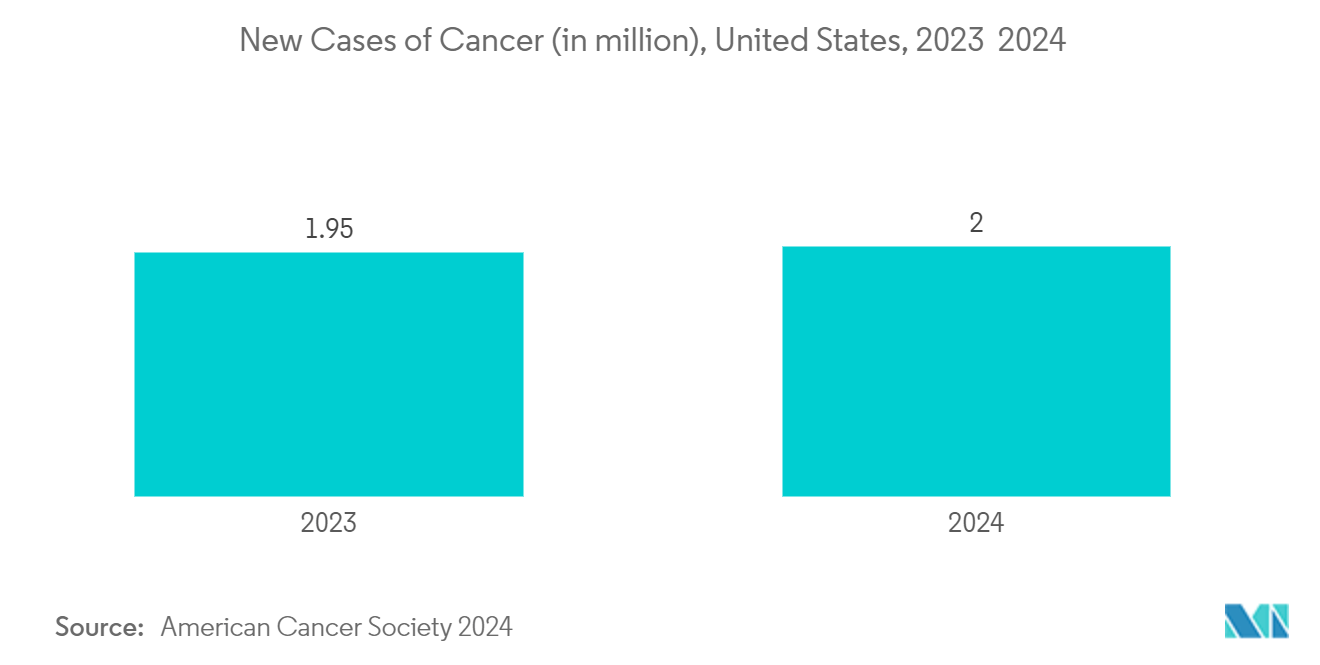
North America is Expected to Hold Significant Market Position In the Complex Injectables Market Over the Forecast Period
North America is expected to hold a significant market share in the complex injectables market and is projected to exhibit a high growth rate. Factors such as increased demand for novel injectables and a surge in regulatory approvals of complex injectables are expected to drive regional market growth. Again, the presence of leading market players and various organic and inorganic developments undertaken by them are further projected to accelerate industry expansion over the study period.
The region's increasing burden of chronic diseases will likely augment demand for complex injectable products. For instance, according to April 2023 data from the Canadian Cardiovascular Society, atrial fibrillation (AFib) is one of the recurrent types of arrhythmia in Canada and affects around 1% to 2% of the general population. Its risk increases with increasing age. Hence, such a remarkable burden of cardiovascular diseases in the region is likely to augment the demand for complex injectables to manage conditions effectively.
Moreover, regional market growth is further driven by the increased efforts by market players to expand injectables manufacturing capabilities. For instance, in June 2024, Amneal Pharmaceuticals, Inc. continued expanding its injectables portfolio with the launch of six new injectable products in early 2024. This expansion increased the total number of commercial injectable products available in the United States. Hence, such efforts by market players to expand injectable products' availability in the United States are likely to bolster the uptake of complex injectables in the region.
Furthermore, the increasing introduction of complex injectable products in North American markets is further projected to augment regional growth. For instance, in August 2024, Lupin Limited launched Doxorubicin Hydrochloride Liposome Injection in two formulations: 50 mg/25 mL (2 mg/mL) and 20 mg/10 mL (2 mg/mL) single-dose vials in the United States. This followed the approval of the Abbreviated New Drug Application (ANDA) by the US Food and Drug Administration (U.S. FDA) to Lupin's alliance partner, ForDoz Pharma Corporation. Hence, such product launches amid supportive regulatory frameworks are expected to offer significant growth opportunities for the market.
Therefore, the factors mentioned above, such as the presence of prominent market players in the region and their various initiatives, are likely to boost regional market growth.
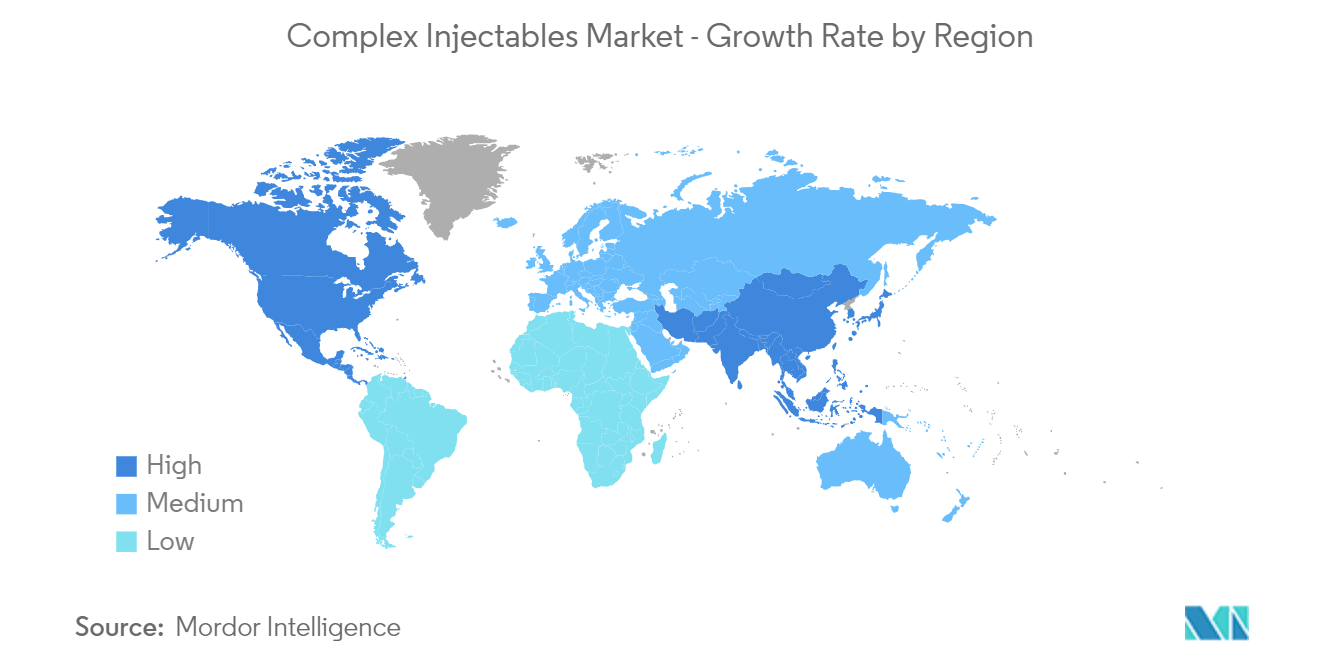
Competitive Landscape
The complex injectables market is semi-consolated in nature and has several significant players. Key players operating in this market are engaged in undertaking various organic and inorganic businesses. strategies to bolster their revenue shares. Some companies currently dominating the market are AbbVie Inc, Accord BioPharma, Inc, Bristol-Myers Squibb Company, Ferring Pharmaceuticals, Fresenius Kabi, Indivior PLC, Novartis AG, and Pfizer Inc, Sun Pharmaceutical Industries Ltd and Tolmar Pharmaceuticals, Inc.
Complex Injectables Industry Leaders
-
AbbVie Inc
-
Bristol-Myers Squibb Company
-
Pfizer Inc
-
Novartis AG
-
Takeda Pharmaceutical Company Limited
- *Disclaimer: Major Players sorted in no particular order
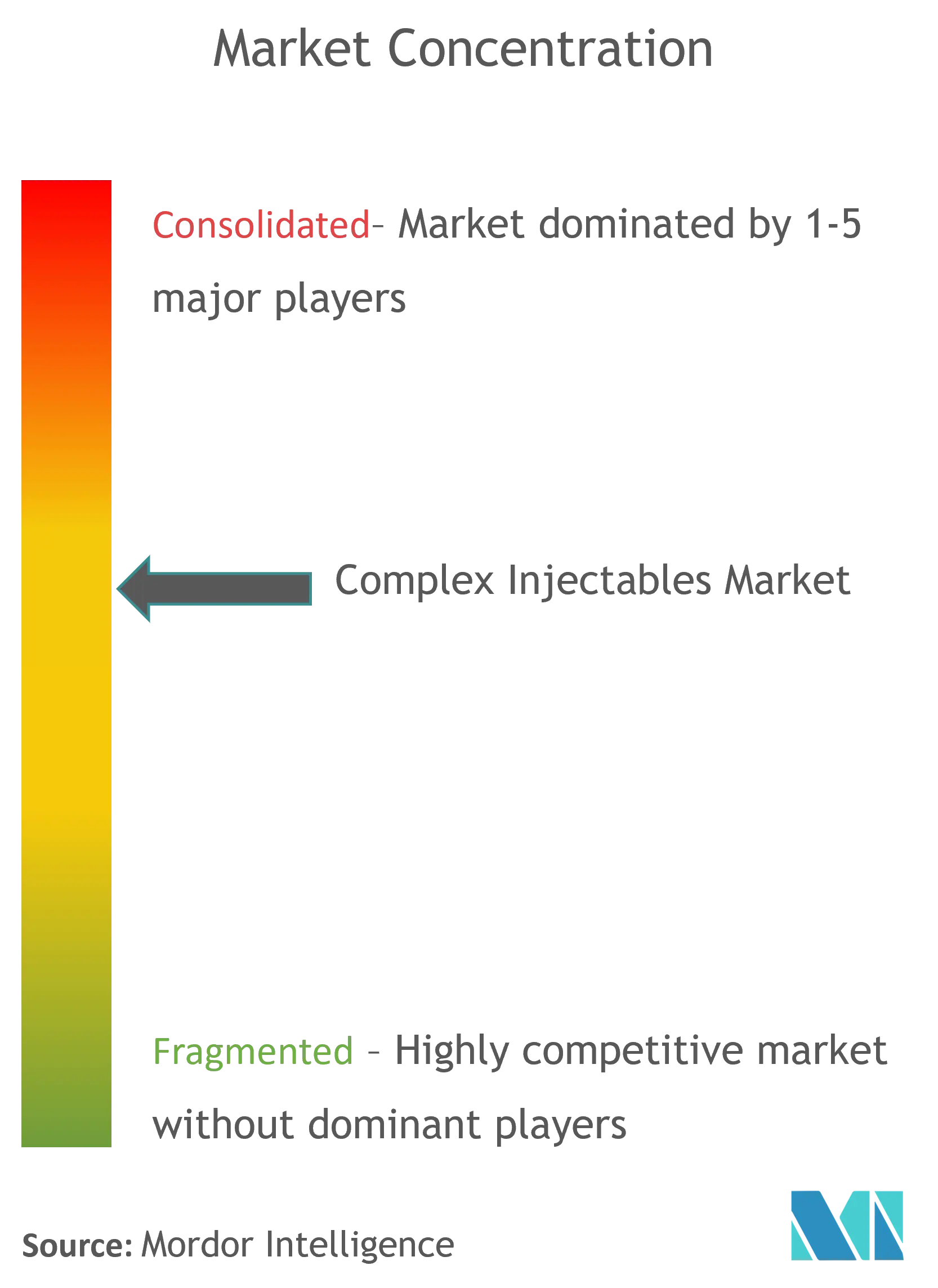
Recent Industry Developments
- April 2024: Innocan Pharma Corporation achieved a significant milestone by submitting its letter of application for a pre-IND meeting. This submission marked the initial phase in the FDA approval process for Innocan's Liposome-Cannabidiol (LPT-CBD) injectable treatment for chronic pain.
- May 2023: American Regent, Inc. launched an injectable suspension containing paclitaxel protein-bound particles to treat patients with certain types of cancer.
Global Complex Injectables Market Report Scope
As per the report’s scope, a complex injectable comprises an intricate active ingredient, formulation, delivery route, or combination of drug devices. These injectables are designed to administer a therapeutic agent via a hollow needle and syringe, penetrating the skin to deliver the substance into the body.
The market is segmented by route of administration, formulation, drug molecule, application, and geography. Based on the route of administration, the market is segmented into intramuscular (IM), intravenous (IV), and subcutaneous. The market is segmented based on formulation into liposomes, microspheres, and other formulations. Based on drug molecule, the market is segmented into, leuprolide, octreotide, paclitaxel, pegasparagase, risperidone, and others. By application, the market is segmented into cardiovascular, cancer, central nervous system disorders, diabetes, endocrinology, and other disorders. By geography, the market is segmented as North America, Europe, Asia Pacific, Middle East and Africa, and South America. The report also covers the market sizes and forecasts for the complex injectables market in major countries across different regions. The market size is provided for each segment in terms of value (USD).
| Intramuscular (IM) |
| Intravenous (IV) |
| Subcutaneous |
| Liposomes |
| Microspheres |
| Other Formulations |
| Leuprolide |
| Octreotide |
| Paclitaxel |
| Pegasparagase |
| Risperidone |
| Others |
| Cardiovascular |
| Cancer |
| Central Nervous System Disorders |
| Diabetes |
| Endocrinology |
| Other Disorders |
| North America | United States |
| Canada | |
| Mexico | |
| Europe | Germany |
| United Kingdom | |
| France | |
| Italy | |
| Spain | |
| Rest of Europe | |
| Asia-Pacific | China |
| Japan | |
| India | |
| Australia | |
| South Korea | |
| Rest of Asia-Pacific | |
| Middle East and Africa | GCC |
| South Africa | |
| Rest of Middle East and Africa | |
| South America | Brazil |
| Argentina | |
| Rest of South America |
| By Route of Administration | Intramuscular (IM) | |
| Intravenous (IV) | ||
| Subcutaneous | ||
| By Formulation | Liposomes | |
| Microspheres | ||
| Other Formulations | ||
| By Drug Molecule | Leuprolide | |
| Octreotide | ||
| Paclitaxel | ||
| Pegasparagase | ||
| Risperidone | ||
| Others | ||
| By Application | Cardiovascular | |
| Cancer | ||
| Central Nervous System Disorders | ||
| Diabetes | ||
| Endocrinology | ||
| Other Disorders | ||
| Geography | North America | United States |
| Canada | ||
| Mexico | ||
| Europe | Germany | |
| United Kingdom | ||
| France | ||
| Italy | ||
| Spain | ||
| Rest of Europe | ||
| Asia-Pacific | China | |
| Japan | ||
| India | ||
| Australia | ||
| South Korea | ||
| Rest of Asia-Pacific | ||
| Middle East and Africa | GCC | |
| South Africa | ||
| Rest of Middle East and Africa | ||
| South America | Brazil | |
| Argentina | ||
| Rest of South America | ||
Key Questions Answered in the Report
How big is the Complex Injectables Market?
The Complex Injectables Market size is expected to reach USD 111.25 billion in 2025 and grow at a CAGR of 8.52% to reach USD 167.44 billion by 2030.
What is the current Complex Injectables Market size?
In 2025, the Complex Injectables Market size is expected to reach USD 111.25 billion.
Who are the key players in Complex Injectables Market?
AbbVie Inc, Bristol-Myers Squibb Company, Pfizer Inc, Novartis AG and Takeda Pharmaceutical Company Limited are the major companies operating in the Complex Injectables Market.
Which is the fastest growing region in Complex Injectables Market?
Asia Pacific is estimated to grow at the highest CAGR over the forecast period (2025-2030).
Which region has the biggest share in Complex Injectables Market?
In 2025, the North America accounts for the largest market share in Complex Injectables Market.
What years does this Complex Injectables Market cover, and what was the market size in 2024?
In 2024, the Complex Injectables Market size was estimated at USD 101.77 billion. The report covers the Complex Injectables Market historical market size for years: 2019, 2020, 2021, 2022, 2023 and 2024. The report also forecasts the Complex Injectables Market size for years: 2025, 2026, 2027, 2028, 2029 and 2030.
Page last updated on:
Complex Injectables Market Report
Statistics for the 2025 Complex Injectables market share, size and revenue growth rate, created by Mordor Intelligence™ Industry Reports. Complex Injectables analysis includes a market forecast outlook for 2025 to 2030 and historical overview. Get a sample of this industry analysis as a free report PDF download.
